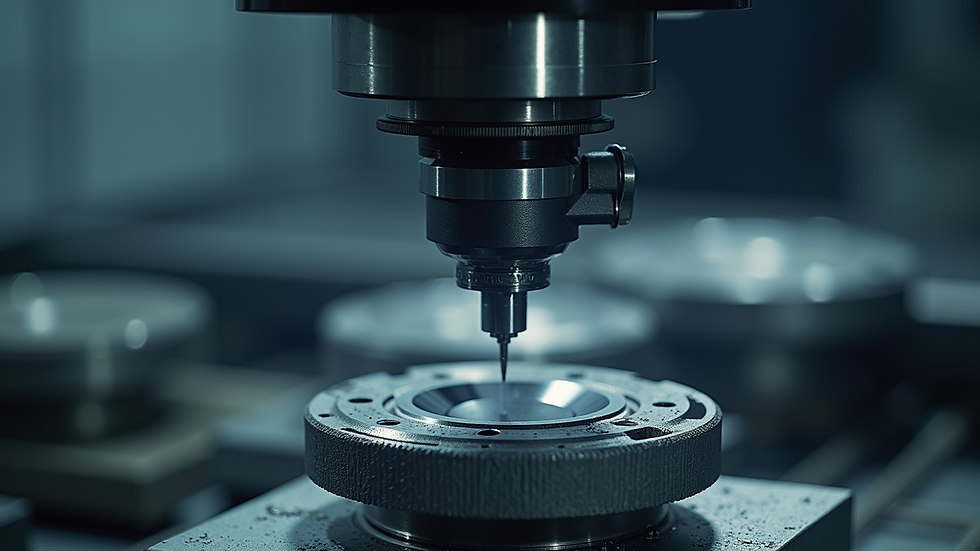Achieving Excellence with Advanced CNC Techniques
- sanshiaerotech
- Jul 19
- 4 min read
In today's fast-paced manufacturing world, achieving excellence in production processes is more crucial than ever. Industries are adopting advanced CNC (Computer Numerical Control) techniques to ensure precision, efficiency, and remarkable quality in machining. This blog explores innovative CNC methods and how they contribute to achieving excellence in precision machining.
Understanding Precision Machining
Precision machining refers to the process of removing material from a workpiece to achieve exact dimensions and tolerances. It relies on advanced machinery and computer programming to create intricate shapes and designs that meet specific industry standards. This process is widely used in sectors like aerospace, automotive, and medical equipment manufacturing.
Using state-of-the-art CNC machines, manufacturers can produce components that fit together seamlessly and perform reliably. These machines can execute complex tasks with high repeatability, making them essential for mass production and specialized projects alike.

Advanced CNC Techniques
To enhance precision and efficiency, various advanced CNC machining techniques have emerged. Here are some noteworthy methods:
1. 5-Axis CNC Machining
Five-axis CNC machining allows for the manipulation of the cutting tool in five different directions. This flexibility enables the machining of complex geometries that would be impossible with traditional 3-axis machines. By eliminating the need to reposition the workpiece multiple times, manufacturers save time and reduce errors. Industries that often rely on 5-axis machining include aerospace and medical device manufacturing.
2. CNC Laser Cutting
CNC laser cutting employs high-powered lasers to cut and engrave materials with incredible precision. This technique is favored for its ability to achieve intricate designs while maintaining edge quality. It's largely used in industries such as jewelry making and sheet metal fabrication. With minimal thermal distortion, laser cutting produces cleaner edges and finer details compared to traditional cutting methods.
3. CNC Water Jet Cutting
Water jet cutting is an eco-friendly CNC technique that utilizes high-pressure water mixed with abrasives to slice through materials. It can cut almost any material, including metals, stone, and glass, without generating heat. This technique is ideal for scenarios where heat distortion must be avoided, such as in the fabrication of sensitive electronic components.

How Much Does CNC Machining Service Cost?
The cost of CNC machining services can vary significantly based on several factors, including the complexity of the project, the material used, and the required tolerances. On average, simple parts may range from $50 to $100 per hour of machining time, while more complex components could range from $100 to $300 per hour.
Other considerations include setup time, tooling, and finishing processes, which can also add to the overall cost. For precise estimates, it's best to consult with a service provider that specializes in precision CNC machining services, such as Sanshia Aero Tech.
The Role of Software in CNC Machining
Modern CNC machines are heavily reliant on software to achieve advanced machining capabilities. Computer-aided design (CAD) and computer-aided manufacturing (CAM) software play essential roles in ensuring precision.
CAD Software: This is used to create detailed designs and specifications for parts. Designers can visualize the components and ensure they meet all necessary tolerances. CAD software enables modifications quickly, which is crucial for prototyping.
CAM Software: After the design is finalized, CAM software generates the necessary code to guide the CNC machine. This ensures that every operation—from cutting to finishing—is executed with pinpoint accuracy.
By utilizing these technologies, manufacturers can optimize their production processes, reduce waste, and ensure superior product quality.

Best Practices for Successful CNC Machining
Achieving excellence in CNC machining requires adhering to best practices. Here are some recommendations that can help:
Invest in Quality Machinery: The precision and longevity of CNC machines significantly affect production quality. Investing in reliable, high-end machines pays off in the long run.
Regular Maintenance: Proper maintenance is crucial for keeping CNC machines in optimal working condition. Regular checks can prevent breakdowns and ensure consistent accuracy.
Continuous Training: Operators should receive ongoing training to stay abreast of new technologies and techniques in CNC machining. This enhances skill levels and ensures the workforce can handle complex tasks efficiently.
Implementing Quality Control: Regular inspections and quality control checks should be a part of the production process. This includes measuring tolerances and ensuring components meet specifications before they are shipped.
By following these practices, manufacturers can significantly reduce costs, improve productivity, and maintain a competitive edge in the market.
Future of CNC Machining
As technology advances, the future of CNC machining looks promising. Innovations such as artificial intelligence (AI) and the Internet of Things (IoT) are expected to play significant roles in efficiency and automation.
AI-driven CNC machines can learn from previous operations, reducing errors over time. Similarly, IoT will enable machines to communicate with one another and share data, allowing for smarter, more connected manufacturing ecosystems.
In addition, as sustainability becomes increasingly important, the use of eco-friendly materials and techniques will likely gain traction in CNC machining. This shift meets consumer demand for environmentally conscious products and reduces waste in the production process.
By embracing these technologies, manufacturers can position themselves strategically for future growth and success.
Elevating Production with Advanced CNC Machining
Achieving excellence in manufacturing is no longer optional; it’s a requirement for survival in today’s competitive landscape. Embracing advanced CNC techniques ensures precision, efficiency, and remarkable quality in production processes. By investing in advanced machinery, software, and best practices, manufacturers can elevate their production capabilities and meet modern demands.
Whether you're in the aerospace, automotive, or medical field, the future of CNC machining holds immense potential for those willing to innovate and adapt to advancements.
In an ever-evolving industry, aligning your strategies with cutting-edge CNC technologies will undoubtedly lead to unparalleled success and sustained excellence.




Comments